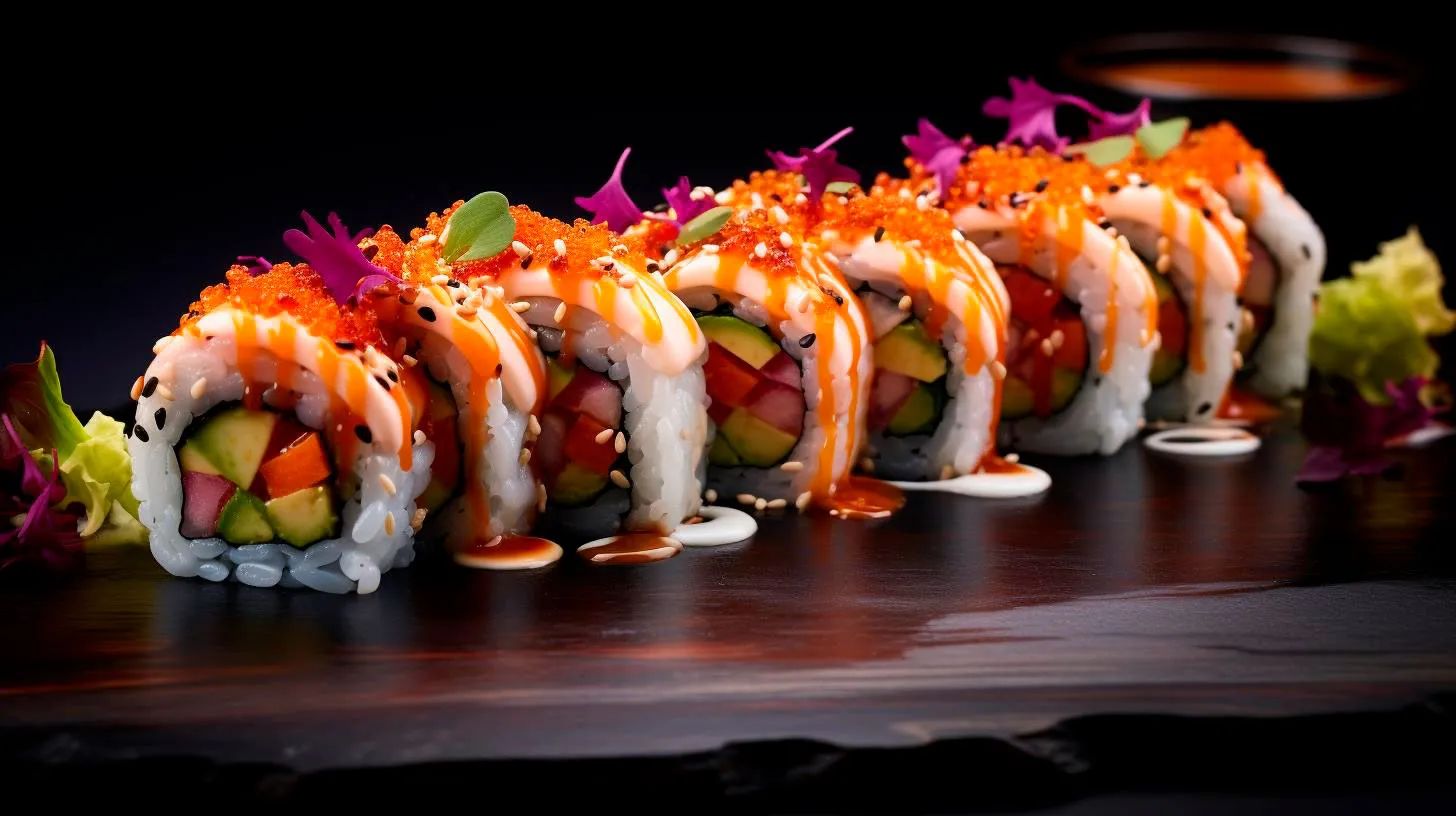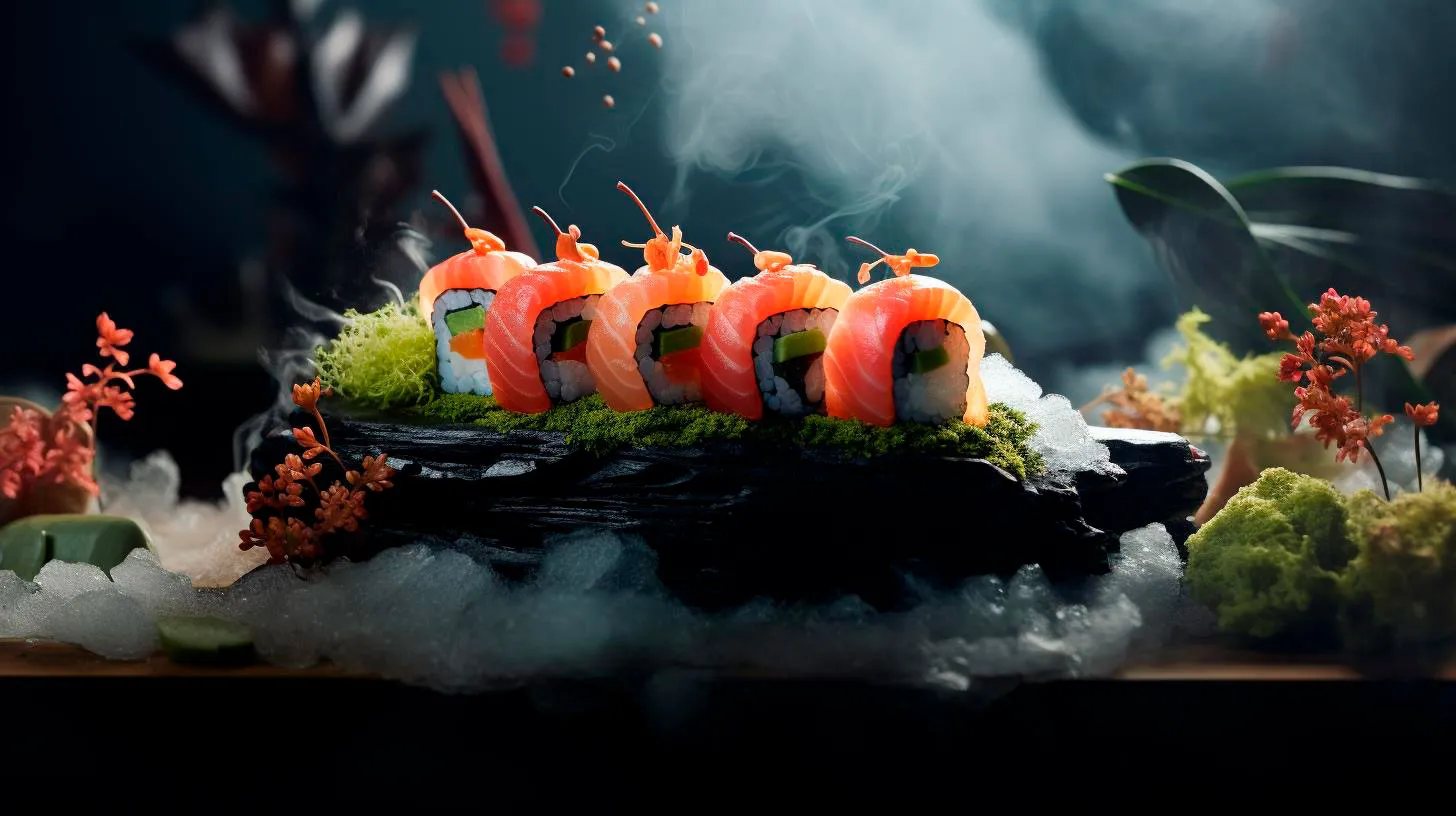The Sushi Revolution Transforming Palates Worldwide
In this article, we will dive deep into the sushi revolution and explore how it is captivating palates worldwide.
The Rise of Sushi
Sushi, once considered a niche cuisine, has gained tremendous popularity in recent years. From high-end sushi bars to casual dining chains, sushi establishments are bustling with eager customers. So, what has fueled the rise of this traditional Japanese dish? Let’s take a closer look:
- Health Benefits: Sushi is not only delicious but also offers various health benefits. It is packed with omega-3 fatty acids, vitamins, and minerals that promote heart health and boost the immune system. The use of fresh ingredients like fish, seaweed, and vegetables adds to its nutritional value.
- Globalization of Palates: As the world becomes more interconnected, people are increasingly open to trying new cuisines. Sushi, with its unique flavors and textures, has captured the attention of food enthusiasts globally. It has become a symbol of cosmopolitan dining, offering a taste of Japan’s rich culinary heritage.
- Social Media and Food Culture: In today’s digital age, social media platforms like Instagram have turned food into an art form. Sushi’s visually stunning presentation, from colorful rolls to meticulous plating, has become a favorite subject for food bloggers and influencers. This online exposure has further ignited interest and curiosity in sushi.
- Increased Availability: Sushi is no longer limited to Japan or upscale restaurants. It has become readily available in supermarkets, convenience stores, and even grab-and-go lunch spots. This accessibility has made sushi a convenient and affordable option for many.
- Adventurous Eating: Food enthusiasts are always seeking new and exciting flavors. Sushi provides a myriad of taste experiences, from traditional nigiri and sashimi to fusion rolls with unexpected ingredient combinations. This adventurous aspect of sushi appeals to those looking to expand their culinary horizons.
Sushi’s Global Impact
The sushi revolution has had a significant impact on international cuisines and dining habits. Let’s explore a few key takeaways:
Cross-Cultural Fusion:
Sushi’s popularity has led to the fusion of Japanese flavors with other culinary traditions. Chefs around the world are incorporating sushi-inspired elements into their dishes, creating a unique blend of flavors. This cross-cultural fusion allows diners to experience the best of both worlds while pushing gastronomic boundaries.
Food Tourism:
Japan has experienced a surge in tourism, partly influenced by its renowned cuisine. Sushi plays a pivotal role in attracting food enthusiasts from all corners of the globe. Travelers flock to Japan to experience authentic sushi at renowned sushi bars, explore local fish markets, and even take part in sushi-making classes.
Healthy Dining Options:
In an era where health-conscious dining is on the rise, sushi presents a healthy alternative to fast food and processed meals. Its emphasis on fresh ingredients and balanced flavors makes it an ideal choice for those seeking nutritious and enjoyable dining experiences.
Economic Opportunities:
The growing demand for sushi has created numerous economic opportunities. From sushi chefs to restaurant owners, the sushi industry generates employment and boosts local economies. Additionally, the international demand for sushi ingredients, such as fish and seaweed, fuels fishing and agriculture industries around the world.
The Future of Sushi
As the sushi revolution continues to reshape the culinary landscape, its future seems promising. Here are some trends and predictions to watch out for:
- Plant-Based Sushi: With the increasing popularity of plant-based diets, expect to see more vegan and vegetarian sushi options. Innovative alternatives to seafood, such as tomato-based “tuna” and avocado rolls, are already gaining traction.
- Sustainable Sourcing: As consumers become more conscious of their environmental impact, sustainable sourcing of ingredients is crucial. Sushi restaurants and suppliers are focusing on responsible fishing practices and promoting local sourcing to minimize their ecological footprint.
- Technological Advancements: Technology continues to influence the food industry, and sushi is no exception. Automated sushi machines and conveyor belt sushi restaurants are emerging as convenient and efficient ways to serve sushi to a larger audience.
- Creative Flavor Combinations: Chefs are constantly pushing the boundaries of traditional sushi by experimenting with exciting flavor combinations. From fusion rolls integrating diverse cuisines to unique sauce pairings, sushi lovers can expect a continued evolution of taste.
The sushi revolution has indubitably transformed palates worldwide. With its healthy attributes, cross-cultural influence, and culinary creativity, sushi has become much more than a meal – it’s an experience. So, whether you’re a sushi aficionado or new to this culinary delight, the sushi revolution welcomes everyone to explore its diverse flavors and embrace a taste of Japan.
From Niche to Global Sushi: A Spectacular Journey
The Origins of Sushi
Sushi has a rich history dating back to the 8th century in Japan. Originally, it was a preservation method where fish was fermented with salt and rice, consumed only after the fermentation process was complete. But as time passed, sushi evolved and transformed into the delicacy we know today.
During the Edo period in the 19th century, street food stalls in Japan popularized sushi. Yohei Hanaya, a famous sushi chef, introduced nigiri sushi, revolutionizing the way sushi was prepared and consumed. This innovation paved the way for sushi’s journey beyond Japan’s borders.
The Evolution of Sushi
Today, sushi has become an art form, with highly skilled chefs crafting exquisite pieces that are not only visually appealing but also bursting with flavor. Sushi has taken on diverse forms to cater to different palates and preferences around the world. Let’s explore some of the key varieties:
- Nigiri Sushi: A classic form consisting of bite-sized rice topped with a slice of raw fish or seafood.
- Maki Sushi: Rolled sushi with seaweed (nori) wrapped around a filling of rice, fish, and vegetables.
- Sashimi: Thinly sliced raw fish or seafood served without rice, allowing the pure flavors to shine through.
- Temaki: Hand-rolled sushi cones filled with a combination of rice, fish, vegetables, and sauces.
Sushi Goes Global
The popularity of sushi skyrocketed in the latter half of the 20th century as it made its way beyond Japan’s borders. Several factors contributed to sushi’s global success:
Health Consciousness
In an era where healthy eating is highly valued, sushi stands out as a nutritious option. It is low in calories, high in protein, and often incorporates fresh vegetables. Sushi also contains heart-healthy Omega-3 fatty acids found in fish like salmon and tuna.
Adventurous Palates
As people became more open to experimenting with new flavors, sushi found its place on menus worldwide. The unique combination of flavors, textures, and presentations in sushi appealed to adventurous eaters seeking novel gastronomic experiences.
Social Media and Celebrity Endorsements
The rise of social media platforms like Instagram played a significant role in spreading the visual appeal of sushi. Influencers, bloggers, and celebrities started showcasing their sushi experiences, inspiring others to give it a try.
Increased Global Travel
With the growth of international travel, people had the opportunity to taste sushi while exploring different cultures. This exposure increased the demand for sushi even in places where Japanese cuisine was not traditionally popular.
The Future of Sushi
As sushi continues to captivate taste buds worldwide, several key trends are shaping its future:
- Sustainability: Sushi restaurants are increasingly focusing on sustainable sourcing practices to protect fish populations and the environment.
- Innovation: Chefs are pushing the boundaries of sushi, experimenting with unique ingredients and creative flavor combinations to surprise and delight diners.
- Technology: Sushi delivery robots, automated sushi-making machines, and online ordering systems are revolutionizing the way sushi is prepared and consumed.
Sushi has undoubtedly come a long way from its humble beginnings. With its fusion of traditional flavors and modern adaptations, sushi has become a global sensation. Whether you are an adventurous foodie or a health-conscious individual, sushi offers a delightful experience that continues to evolve. So grab those chopsticks and embark on a culinary adventure through the diverse world of sushi!
Exploring the Global Craze: Sushi’s Unstoppable Ascension
In this article, we will delve into the global craze for sushi and explore its unstoppable ascension in the culinary world.
The Allure of Sushi
Sushi is a renowned Japanese dish that consists of vinegared rice combined with a variety of ingredients such as raw or cooked seafood, vegetables, and tropical fruits. Its extraordinary taste and visually appealing presentation have captured the hearts and palates of people worldwide. Let’s take a closer look at what makes sushi so irresistible:
- Flavors: The combination of fresh ingredients and seasonings like soy sauce, wasabi, and pickled ginger creates a unique umami flavor that is both savory and refreshing.
- Health Benefits: Sushi is not only delicious but also known for its health benefits. Seafood used in sushi is an excellent source of omega-3 fatty acids, which promote heart and brain health. It is also low in fat and calories, making it a healthier choice compared to many other cuisines.
- Visual Appeal: Sushi’s artistic presentation is a feast for the eyes. With vibrant colors, intricate garnishes, and meticulous arrangement, each sushi roll or nigiri becomes a small work of art.
The Global Sushi Sensation
Sushi’s popularity has transcended cultural boundaries and has become a global sensation. Its widespread appeal can be attributed to the following factors:
- Globalization: With the rise of globalization, people have become more open to experiencing new cuisines and flavors. Sushi, being a prominent part of Japanese cuisine, has found its way onto the menus of restaurants worldwide.
- Health Consciousness: In recent years, health-conscious individuals have turned to sushi as a healthier dining option. Its low-calorie and nutritious composition have made it a popular choice for those seeking a balanced diet.
- Social Media Influence: The power of social media cannot be underestimated when it comes to the popularity of sushi. Mouthwatering photographs and rave reviews shared on platforms like Instagram and Facebook have further fueled the desire to try this delicacy.
Key Takeaways
As sushi continues its unstoppable ascension, there are a few key takeaways to consider:
- Cross-Cultural Appeal: Sushi’s ability to transcend cultural boundaries showcases the growing appreciation for diverse cuisines worldwide.
- Health Benefits: Sushi’s nutritious composition has made it an appealing choice for health-conscious individuals.
- Visual Aesthetics: The visually stunning presentation of sushi elevates the dining experience.
- Social Media Influence: Social media platforms play a significant role in promoting culinary trends, with sushi being a top contender.
In conclusion, the global craze for sushi shows no signs of slowing down. Its unique flavors, health benefits, and visual appeal have captivated people across the world. As sushi continues to evolve and adapt to different cultures, its unstoppable ascension is set to continue. So, why not join the millions who have already embarked on this culinary adventure and give sushi a try?
The Rise of Sushi Popularity
The Flavors that Captivate Taste Buds
One of the key reasons behind the rise of sushi’s popularity is its incredibly diverse and captivating flavors. Sushi offers a wide variety of options to suit every palate. From the delicate and subtle flavors of fresh raw fish to the rich umami taste of soy sauce and the slight tanginess of pickled ginger, every bite is an explosion of taste.
Key Takeaway: The range of flavors in sushi makes it an exciting and enjoyable dining experience.
Health Benefits that Sushi Brings
Sushi lovers can rejoice in the fact that this popular Japanese dish is not only delicious but also packed with health benefits. Sushi is traditionally made with fresh fish, seaweed, and rice, making it a nutritious and well-balanced meal.
- Fish: Sushi often includes different types of fish rich in omega-3 fatty acids, which are essential for heart health.
- Seaweed: Nori, the seaweed used in sushi rolls, is a good source of vitamins and minerals, including iodine and iron.
- Rice: Sushi rice is low in fat and provides carbohydrates for energy, making it a healthier alternative to greasy fast food.
Key Takeaway: Incorporating sushi into your diet can contribute to a healthier lifestyle, providing essential nutrients and promoting heart health.
The Cultural Appeal of Sushi
Sushi is not just about the food itself; it represents a rich cultural heritage deeply rooted in Japan. The attention to detail and precision in its preparation mirrors the Japanese commitment to craftsmanship. This cultural appeal has made sushi not only a culinary delight but also an experience that transports diners into another world.
Key Takeaway: Sushi offers more than just a meal; it provides a glimpse into the rich traditions and artistry of Japanese culture.
Sushi: A Rising Trend Globally
The rise in sushi’s popularity is not limited to Japan or a few select countries. Sushi has permeated cultures worldwide, becoming a global phenomenon. Here are some statistics that showcase sushi’s growing demand:
- The global sushi market is estimated to grow at a CAGR of 4.1% from 2020 to 2027, reaching a value of $47.9 billion by 2027.
- In the United States alone, sushi consumption has increased by 28% over the last five years.
- Sushi has become a staple in many European countries, with annual consumption increasing by 10% on average.
Key Takeaway: Sushi is not just a food trend but a rapidly growing industry worldwide, demonstrating its immense popularity.
Conclusion
Sushi has undoubtedly risen in popularity over the years, captivating taste buds globally with its diverse flavors. The health benefits, cultural appeal, and growing consumer demand have contributed to this boom. Whether you choose to indulge in a classic tuna roll or explore more adventurous sushi creations, this Japanese delicacy offers a feast for the senses.
So, why not treat yourself and join the sushi trend? Your taste buds and health will thank you!


